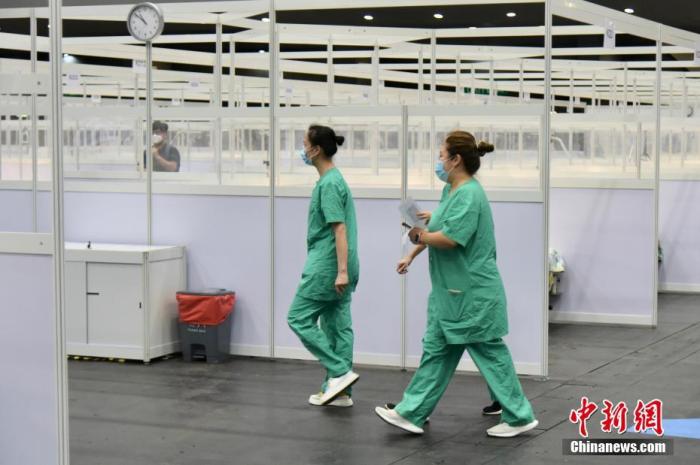(Fighting against New Coronary Pneumonia) "Hong Kong version of Fangcang shelter hospital" officially opened: about 30 patients and 14 doctors were admitted on the first day
China News Service, Hong Kong, August 1st, title: "Hong Kong version of the shelter hospital" officially opened: about 30 patients and 14 doctors were admitted on the first day
China News Agency reporter Han Xingtong
In response to the severe new crown pneumonia epidemic in Hong Kong and to relieve the pressure of isolation beds in public hospitals, the Asian World Expo (Asian Expo) community treatment facility, known as the "Hong Kong version of the square cabin hospital", was officially opened on August 1. On the first day of admission, about 30 patients were admitted, and a total of 14 doctors were deployed by the Hong Kong Hospital Authority (HA).
It is reported that the AsiaWorld-Expo Community Treatment Facility will adopt "age diversion, increase revenue and reduce expenditure" as its operating policy, and mainly treat confirmed patients aged 18 to 60. Approximately 500 hospital beds can be provided in the first stage. According to Li Liye, a consultant in the emergency department of Tin Shui Wai Hospital, the AsiaWorld-Expo mainly accepts confirmed patients with mild symptoms who are still waiting to be admitted to divert patients from the community and relieve the pressure on the hospital.
On August 1, the Hong Kong Hospital Authority opened a community treatment facility at the AsiaWorld-Expo. The picture shows that there are lockers and tables in a separate patient compartment. Photo by China News Agency reporter Li Zhihua
The reporter noticed during an interview at the “Hong Kong Square Cabin Hospital” on the 1st that the community treatment facility is located in Hall 1 of the Asia Expo, and there are working areas for medical staff outside the venue, including the central control center and the medical and nursing wear protective equipment area; Next to a row of large screens are the CCTV monitoring screens of each area in the venue, and the e-health cloud data system. The system displays the vital signs of each patient, such as heart rate, blood oxygen, body temperature, etc., which medical staff can see at a glance.
At the same time, the medical staff will also confirm the condition of the patients in the field through video calls and other methods. If the patient has any discomfort, they can also call the hotline to seek help from the medical staff. contact.
The first batch of patients arrived by ambulance at noon on the 1st. Medical staff wearing full protective equipment were present to prepare. Li Liye revealed that a total of 14 doctors were deployed on the first day of illness, and it is expected to increase to 28 in one week. A total of 50 nurses were recruited. He also expects to receive about 30 patients per day for the first two days, and this will continue to increase thereafter.
On August 1, medical staff made a patrol before the start of the treatment facility to ensure safety.
The admission reception desk is set up at the entrance where it is convenient for ambulances to park, and provides "one-stop" service. After the patient arrives, register his personal data at the reception desk; then go to the nurse’s station to enter the vital signs numbers into the system, and be issued a card to enter the relevant numbers in the future; after that, the patient will be transferred to the doctor to confirm whether it is necessary Check blood etc. After completing these, the patient can enter the ward to rest.
The ward of the facility is divided into hundreds of compartments, each compartment is placed with beds, tables and chairs, cabinets and lamps. There are also shower rooms, X-ray rooms and 8 self-service vital sign measuring machines. Before 9 o'clock in the morning, patients need to measure their own vital signs such as blood pressure and body temperature, and enter the numbers into the electronic system. Every other day, they need to collect deep throat saliva samples for virus testing or receive blood draws for antibody testing. X-rays are also required. It is done every other day.
The Chief Nurse Leung Ming of the Hospital Authority added that for infection control considerations, most of the operations on the premises use electronic systems, striving for paperlessness throughout the process. Liang Ming also said that since the patients staying in the community treatment facilities are relatively healthy and capable of self-care, the overall arrangement enhances the autonomy of the patients, and they will do everything they can, such as taking meals and taking meals by themselves. Medicine etc. (Finish)

